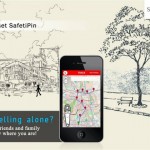 Earlier this year I wrote about a new project that is using the crowd to help improve our awareness of the safety of our cities.
Earlier this year I wrote about a new project that is using the crowd to help improve our awareness of the safety of our cities.
The project is built on a 2011 venture called Place Pulse, which I covered a few years ago, which gave people two Google Street View images of a city and asked them to choose the one that appeared more desirable.
The latest project, called StreetScore, sees a high resolution map of urban perceptions created based upon the data from the Place Pulse project. The aim is for the data to support research into any connections between perceptions of an area and crime rates.
Improving urban safety
This MIT led effort is not the only attempt to increase our safety however. Another such effort is called Safetipin, which was created by the Jagori charity.
The app utilizes the crowd to produce a safety rating for New Delhi, with ratings taking account of things like lighting, transport, and population density.
Interestingly, the app also provides GPS tracking capabilities, so friends and family can trace you down should you wish them to.
Keeping women safe
Safetipin is one of many projects that are part of a wider UN led initiative to reduce the number of rapes and other sexual assaults in urban areas around the world.
The effort, which goes by the name of the UN Women’s Safe Cities Global Initiative, is seeing projects in places across the world working to make our towns and cities safer for women.
“Unsafe public spaces limit women’s and girl’s life choices. This daily reality limits their freedom to participate in education, work and recreation, and in political life,” the UN say.
“In many cities, adolescent girls are afraid to walk on their own on the streets in their neighbourhoods when they go to school because they experience various forms of sexual harassment, such as cat-calling, stalking, whistling and touching,” they continue.
With estimates suggesting that 1 in 3 women around the world have experienced some form of physical or sexual violence, it’s clearly a pressing issue.
The issue rose to particular prominence in New Delhi after a young woman was brutally gang-raped on an unlicensed bus back in 2012. The attack, and the subsequent death of the victim from the injuries she suffered, sparked protests around the world and cast the spotlight on the scale of the problem.
The incident has led to a rise in the number of cases that are reported by women, with police in the city revealing a 32 percent rise in reported rapes last year.
New Delhi has joined with 25 other cities around the world in becoming Safe Cities members, with a range of initiatives, be they better street lighting, providing helplines or even installing female toilets, launched as part of the venture.
Of course, the apps are not the only means by which authorities and charities are hoping to make women safer, but they are nonetheless an important part of a crucial, and ongoing, battle to make our cities a better place to live for all residents.
Every little helps, right? Thanks for sharing Adi.